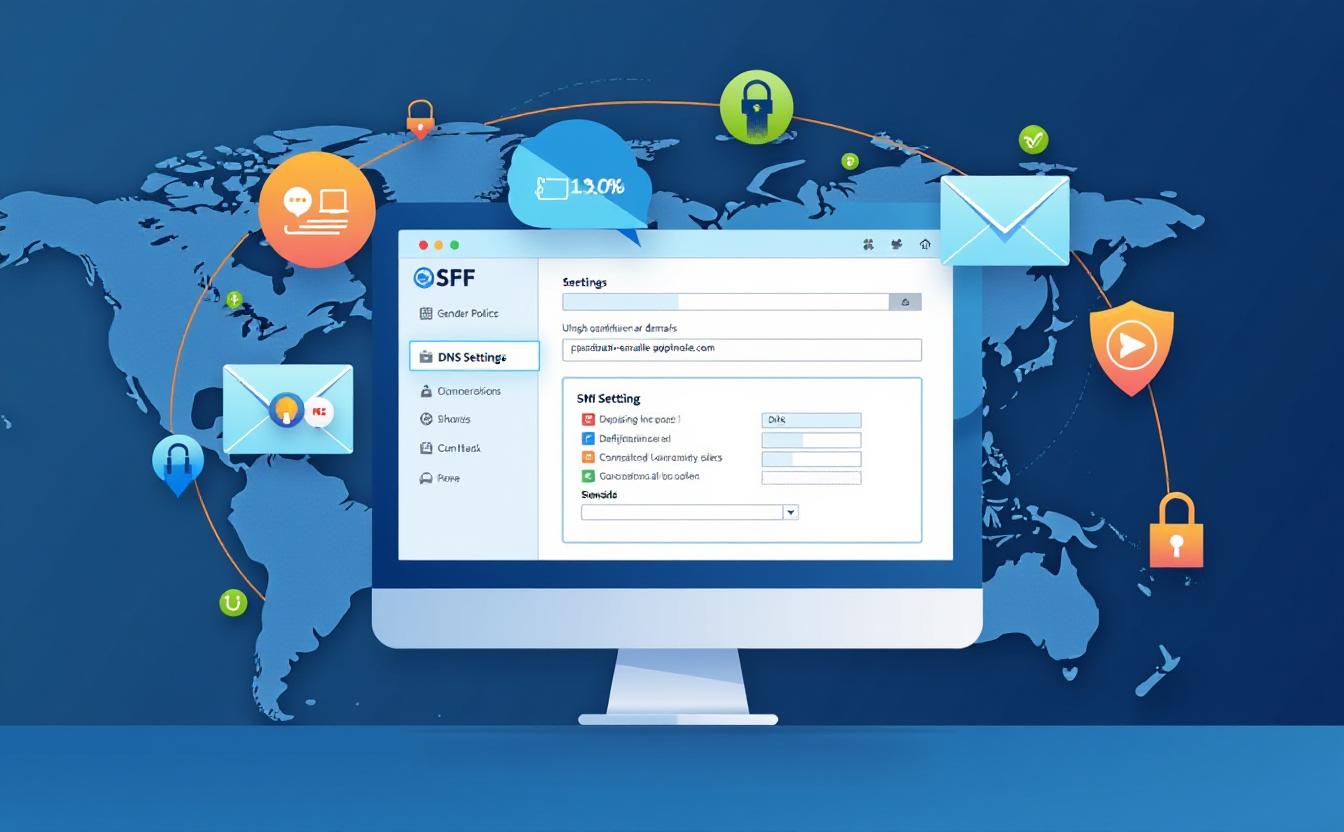Understanding SPF Records and How to Verify Them

Understanding SPF Records and How to Verify Them
Table of Contents
- What is an SPF Record?
- The Importance of SPF Records in Email Authentication
- How SPF Records Work: A Technical Overview
- Common Misconceptions About SPF Records
- Step-by-Step Guide to Creating an SPF Record
- How to Check Your SPF Record: Tools and Techniques
- Troubleshooting SPF Record Issues
- Best Practices for Managing SPF Records
What is an SPF Record?
Sender Policy Framework (SPF) is an email authentication method designed to detect and prevent email spoofing. An SPF record is a DNS (Domain Name System) record that specifies which mail servers are allowed to send emails on behalf of your domain. It helps receiving email servers verify that an email claiming to come from your domain is indeed sent from an authorized server. This process enhances email deliverability and protects your domain's reputation by reducing the chances of phishing attacks.
The Importance of SPF Records in Email Authentication
SPF records play a crucial role in email security. They help prevent unauthorized parties from sending emails that appear to originate from your domain, which can lead to spam, phishing attacks, and domain reputation damage. By implementing SPF records, you can: Improve Email Deliverability: Emails from your domain are more likely to be delivered to recipients' inboxes rather than being marked as spam. Protect Against Spoofing: SPF records make it more difficult for attackers to impersonate your domain. Enhance Domain Reputation: A well-configured SPF record contributes to the overall reputation of your domain, making your emails more trustworthy.
Tip
If you offer your SEO texts in several languages or localize them for different regions, your pages may be incorrectly classified as duplicate content. However, there is a simple solution to this in the form of hreflang. Our article explains what you need to bear in mind when using hreflang.
Read more about hreflangHow SPF Records Work: A Technical Overview
SPF records are defined in the DNS as a TXT record. When an email is sent, the recipient’s mail server checks the SPF record of the sender’s domain. This process involves the following steps: DNS Lookup: The receiving server queries the DNS for the SPF record associated with the sender’s domain. Validation: The receiving server checks the IP address of the sending server against the list of authorized IPs specified in the SPF record. Result: Depending on the match, the receiving server decides whether to accept, reject, or flag the email as spam. SPF can return results like "Pass," "Fail," "Softfail," or "Neutral," indicating the outcome of the verification.
Common Misconceptions About SPF Records
There are several misconceptions surrounding SPF records: SPF Records Alone Ensure Email Security: SPF is one part of a multi-layered email authentication strategy. It should be used alongside DKIM (DomainKeys Identified Mail) and DMARC (Domain-based Message Authentication, Reporting & Conformance) for comprehensive email protection. SPF Records Can Fully Prevent Spoofing: While SPF helps reduce spoofing, it does not completely eliminate it. Attackers can still forge email headers, so additional measures like DKIM and DMARC are necessary for enhanced security. A Single SPF Record is Sufficient for All Domains: Different subdomains may require their own SPF records. It's important to configure SPF records for each subdomain that sends emails.
Step-by-Step Guide to Creating an SPF Record
Creating an SPF record involves a few steps: Identify Authorized Mail Servers: Determine which mail servers are allowed to send emails for your domain. This may include your web hosting provider, email marketing services, and any other services you use. Construct the SPF Record: The SPF record will look something like this:
makefile
v=spf1 ip4:192.0.2.1 include:example.com -all
v=spf1 indicates the version of SPF being used. ip4:192.0.2.1 specifies an authorized IP address. include:example.com allows servers listed in the specified domain's SPF record to send emails on your behalf. -all indicates that all other servers are not authorized. Add the SPF Record to DNS: Log in to your DNS provider's management console and add a new TXT record with your constructed SPF string. Save Changes: After adding the record, save your changes. DNS updates may take some time to propagate.
How to Check Your SPF Record: Tools and Techniques
Verifying your SPF record is essential to ensure it's correctly configured. Here are some tools and techniques:
Online SPF Checkers: Several online tools can validate your SPF record, such as MXToolbox, SPF Record Checker, and Kitterman.
Command-Line Tools: Use command-line tools like nslookup or dig to check your SPF record:
For nslookup:
bash
nslookup -type=TXT yourdomain.com
For dig:
dig TXT yourdomain.com
Email Testing Services: Some email services allow you to send test emails and check the results of SPF validation in the email headers.
Troubleshooting SPF Record Issues
If your SPF record is not working as expected, consider the following troubleshooting steps: Check for Syntax Errors: Ensure that your SPF record is correctly formatted without any typos or syntax issues. Review Authorized IPs: Confirm that all your email-sending services are included in your SPF record. Check for DNS Propagation: After making changes, remember that it may take some time for DNS changes to propagate. Allow 24-48 hours before testing again. Use SPF Testing Tools: Utilize online tools to diagnose issues with your SPF configuration.
Best Practices for Managing SPF Records
To ensure your SPF records are effective and secure, follow these best practices: Keep Records Updated: Regularly review and update your SPF records to reflect any changes in your email sending services or infrastructure. Limit the Number of DNS Lookups: SPF records can only include up to 10 DNS lookups. Optimize your record to stay within this limit to avoid failures. Combine with DKIM and DMARC: Implement DKIM and DMARC alongside SPF for a more robust email authentication strategy. Monitor Your Domain’s Reputation: Use tools to monitor your domain’s email reputation and the effectiveness of your SPF records.
| Understanding SPF Records and How to Verify Them | |
|---|---|
| 1. What is an SPF Record? | An SPF (Sender Policy Framework) record is a DNS record that helps prevent email spoofing by specifying which IP addresses are authorized to send emails on behalf of a domain. |
| 2. Why Are SPF Records Important? | SPF records protect against email spoofing by ensuring that emails sent from a domain come from verified sources, thus reducing the risk of phishing and spam. |
| 3. How Does SPF Work? | When an email is sent, the receiving mail server checks the domain's SPF record to verify if the sending server is authorized to send emails on behalf of that domain. |
| 4. How to Create an SPF Record? | To create an SPF record, you need to add a TXT record to your domain's DNS settings, specifying the authorized IP addresses or hostnames allowed to send emails from your domain. |
| 5. How to Check an SPF Record? | You can check your SPF record using DNS lookup tools or command-line utilities like `nslookup` or `dig` to ensure it is properly configured. |
| 6. Common SPF Record Syntax | An SPF record typically begins with "v=spf1" followed by allowed IP addresses or hostnames, ending with mechanisms like "all" or "-all" to define the policy. |
| 7. SPF Alignment and DMARC | SPF works in conjunction with DMARC to enhance email security. Proper SPF alignment helps validate that the email comes from a legitimate sender. |
| 8. Troubleshooting SPF Record Issues | Common SPF issues include syntax errors, exceeding DNS lookup limits, or improper configuration of authorized sending IP addresses, which can cause email deliverability issues. |
FAQs
What is an SPF Record?
An SPF (Sender Policy Framework) record is a DNS entry that specifies which mail servers are authorized to send emails on behalf of your domain. It helps prevent email spoofing and ensures that email servers can verify that your emails are coming from a trusted source.
Why Are SPF Records Important?
SPF records are crucial for email security. They protect against email spoofing and phishing attacks, improve email deliverability, and help maintain your domain's reputation by ensuring only authorized servers send emails on your behalf.
How Do SPF Records Work?
When an email is sent, the receiving server checks the SPF record of the sender's domain. It verifies whether the IP address of the sending server is included in the list of authorized servers. Based on this check, the email is either accepted, rejected, or flagged.
What is the Syntax of an SPF Record?
An SPF record typically starts with "v=spf1" and lists the allowed IP addresses or hostnames. The record may end with "-all" or "~all" to specify how to handle unauthorized email sources.
How Can I Check My SPF Record?
You can use online tools like MXToolbox or command-line utilities like nslookup or dig to check if your SPF record is correctly configured and active.
What Common Issues Arise with SPF Records?
Common issues include exceeding DNS lookup limits, improper configuration of authorized IP addresses, and syntax errors. These issues can lead to email delivery failures or security vulnerabilities.
What Are Best Practices for SPF Record Management?
Regularly review and update your SPF records, minimize DNS lookups to stay within limits, and use SPF alongside DKIM and DMARC for enhanced email security. Monitoring your domain's reputation is also essential.
Can SPF Records Alone Secure My Emails?
No, SPF records are only one part of a comprehensive email security strategy. For optimal protection, combine SPF with DKIM (DomainKeys Identified Mail) and DMARC (Domain-based Message Authentication, Reporting & Conformance).










